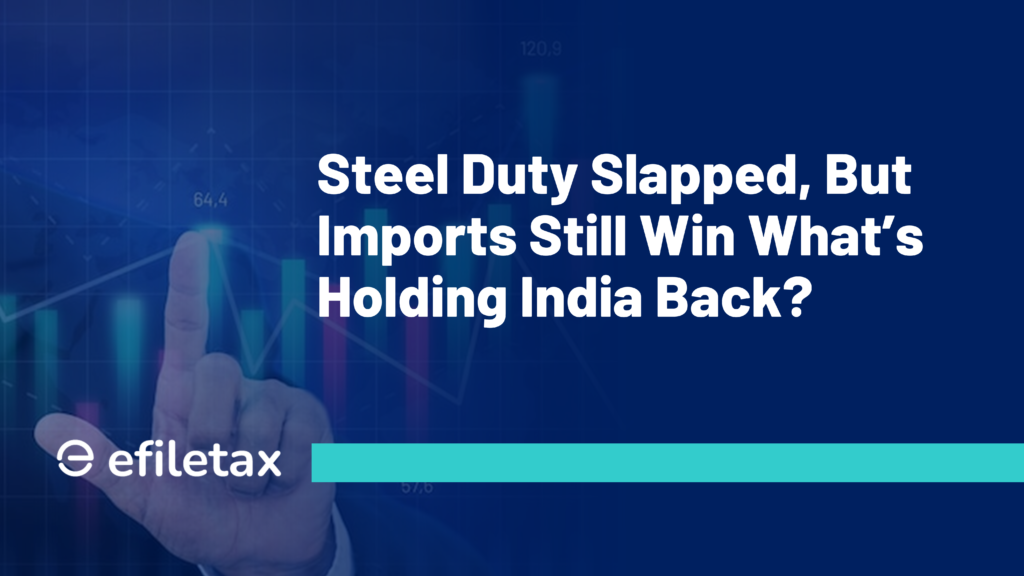
Why Safeguard Duty on Steel Isn’t Solving the Import Problem
India imposed safeguard duty on steel to protect domestic players. Despite this move, the country remains a net importer of finished steel as of April 2025. Let’s break down why the safeguard duty hasn’t delivered the full result, and what it means for Indian businesses and taxpayers.
What Is Safeguard Duty on Steel?
Safeguard duty is a temporary tariff imposed to protect domestic industries from import surges.
In India’s case:
- Imposed by: Directorate General of Trade Remedies (DGTR) under Ministry of Commerce
- Legal Backing: Section 8B of Customs Tariff Act, 1975
- Purpose: Shield Indian manufacturers from cheaper steel imports, mainly from China, Korea, and Vietnam
Key Data for April 2025
| Metric | April 2025 | April 2024 |
|---|---|---|
| Finished Steel Imports | 0.53 million tonnes | 0.46 million tonnes |
| Export of Finished Steel | 0.40 million tonnes | 0.55 million tonnes |
| Net Import Position | Importer | Exporter |
| Top Import Sources | China, Vietnam, Korea | Same |
Source: Ministry of Steel, GoI: steel.gov.in
Why the Duty Isn’t Working
Even with safeguard duty, India’s import dependence persists due to:
- Price Competitiveness: Foreign steel remains cheaper even after duty
- High Input Costs: Domestic manufacturers face higher costs for iron ore, coal, and power
- Special Grades: India imports specialty steel not produced in adequate quantity locally
- Trade Agreements: FTA routes (e.g., with ASEAN) often bypass full-duty application
Government’s Legal and Policy Response
- Notification Ref. No. 01/2024-Customs (SG) – Imposed 25% safeguard duty for 200 days in March 2024
- DGTR Reports – Periodic reviews continue for long-term tariff planning
- PLI Scheme for Steel – ₹6,322 crore incentive plan to boost domestic capacity
Read the official safeguard duty notification
It’s Not Just About Duty
Comment from a Policy Consultant:
“Safeguard duty helps short-term. But long-term resilience comes from reducing domestic input costs and expanding alloy-grade capabilities.”
Practical Insight for Indian MSMEs
If you’re in construction or auto sector:
- Expect stable steel prices in domestic market due to lower global demand
- But import delays may rise due to tighter customs checks on safeguard-covered items
- Plan sourcing contracts with both local and global vendors to reduce supply risk
FAQ: Safeguard Duty on Steel
Q1: Is safeguard duty permanent?
No. It’s temporary—up to 4 years under WTO rules, extendable based on review.
Q2: Is safeguard duty the same as anti-dumping duty?
No. Anti-dumping targets unfair pricing; safeguard duty targets import surges.
Q3: Will safeguard duty increase prices?
Slightly, yes. But it’s aimed to stabilize local production and protect jobs.
Final Thoughts
The safeguard duty on steel is not a silver bullet. It slows down dumping but doesn’t fix India’s core competitiveness issues. To truly reduce dependence on steel imports, India must ramp up domestic production of high-grade and cost-effective steel.
Summary
Despite safeguard duty on steel, India remains a net importer in April 2025. Imports rose to 0.53 MT while exports fell. Factors include cheaper foreign steel, high domestic costs, and special grade needs. Efiletax explains why the safeguard duty isn’t enough and what Indian businesses must watch.